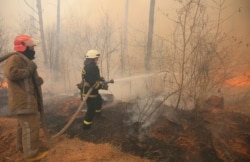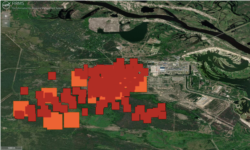On Tuesday, April 14, Ukrainian firefighters contained wildfires that have been raging for more than a week through Chernobyl’s exclusion zone – an area contaminated with radiation from the nuclear power plant accident there in 1986.
The fire raged some 19 miles into the zone and was stopped just 600 feet from the Chernobyl plant itself, the BBC reported.
Ukraine’s Emergency Situations Service said most of the fire was extinguished, but smoldering sections of forest floor remained throughout western parts of the 1,000-square-mile exclusion zone. Rainfall after a weeks-long dry period helped, the agency said.
The fire in Chernobyl came amid the panic over the COVID-19 pandemic, prompting a surge of apocalyptic memes on social media but also raising concerns that smoke and wind could potentially spread radioactive contamination.
International media reported elevated radiation levels in the area of the fire.
The Associated Press cited a member of Ukraine’s public council in charge of Chernobyl exclusion zone, Yaroslav Yemelyanenko, as saying on Facebook that the situation was “critical.”
The Guardian cited a Facebook post by the head of Ukraine’s state ecological inspection service that included a video of a Geiger counter showing a radiation level 16 times above normal.
Reuters reported that aerial images of the exclusion zone around the destroyed nuclear plant “showed scorched, blackened earth and the charred stumps of still smoldering trees.”
Later on Tuesday, Ukraine’s deputy interior minister, Anton Herashchenko, visited Chernobyl and gave assurances that all the fires would be extinguished. He also claimed the radiation level in the area was normal.
“The firefighters did not allow the fire to move towards the town of Pripyat, the Chernobyl nuclear power plant and nuclear waste storage facilities. There was no danger to the nuclear facilities of the Exclusion Zone at this fire. There is no increase in radiation background,” Herashchenko said.
To confirm Herashchenko’s claim, Ukraine’s Emergency Situations Service published a photo showing a firefighter holding a Geiger counter showing a reading of 0.14 microSieverts per hour (mSv/h) – indicating a radiation level considered safe or normal.
The claim is misleading.
Ukraine uses the same system of measuring radiation levels as Russia and Europe. A background radiation level of 0.12 to 0.24 mSv per hour is considered normal.
A chest X-ray delivers 0.1 mSv of radiation and a full-body CT scan 10 mSv. The maximum levels recorded at the Fukushima nuclear power plant in Japan on March 14, 2011, after it melted down as a result of being struck by tsunami, was 400 mSv. Many of the workers at the Chernobyl nuclear power plant when it melted down in April 1986 received doses measuring 6,000 mSv and died within a month.
Despite Herashchenko’s claim of “no increase,” several sources reported what they characterized as elevated levels.
On Monday, Dmitry Shibalov, a member of Ukraine’s Chernobyl council, which oversees the exclusion zone, posted a video on Facebook from the abandoned village of Poliske, located inside the zone, some 36 miles from the defunct power plant. The video shows blackened trees still smoldering, with a Geiger counter in the foreground beeping and showing a reading of 0.42 mSv.
“The level is a little above normal, but not significantly, and it’s very localized,” Shibalov wrote in a caption to the video.
Ukrainian activists posted videos on Facebook taken near the fire in Chernobyl and showing readings as high as 2.3 mSv “at the center of the fire.”
The latest wildfires are the largest in the exclusion zone since the nuclear accident, the head of the Eastern European Fire Monitoring Center, Sergiy Zibtsev, told Agence-France Presse. He estimated that the fires covered more than 50,000 acres in the western part of the zone.
According to several studies and data, previous wildfires in Chernobyl were much smaller (the largest, in 2015, covered 3,700 acres). One study compared the 2015 fires as equivalent to a Level 3 nuclear event, “which corresponds to a serious incident, in which non-lethal deterministic effects are expected from radiation.”
On April 15, Ukraine’s state Scientific Center for Nuclear and Radiation Safety published data of the movement of “potentially contaminated air masses” toward Ukraine’s capital, Kyiv, but said they were not hazardous.
“The forecasted concentrations are not higher than those observed previously and do not pose a threat to the health of the population,” the Center said.
Greenpeace, the environmental group, Tweeted a statement of concern.
“Wildfires near the Chernobyl nuclear power plant burning since April 3 have already become the largest for the entire existence of this exclusion zone. These fires are extremely dangerous because radionuclides located in the upper soil layers might be released into the air,” Greenpeace said in a statement.
The online investigative site Bellingcat reviewed satellite photos and other evidence about the fires, concluding that while there was cause for concern, “some international media outlets have made misleading claims about “spiking radiation levels.”
Citing experts and government sources, the site said that “Local radiation levels seem to have increased, but there has been no immediate risk for citizens being exposed to dangerous levels of radiation.”










